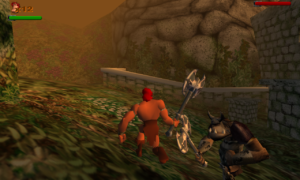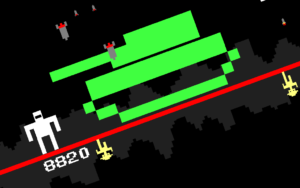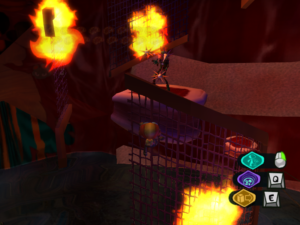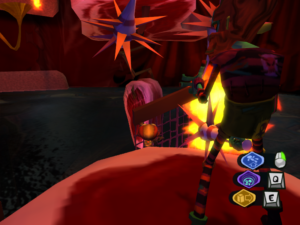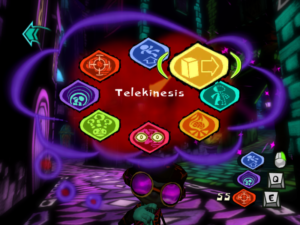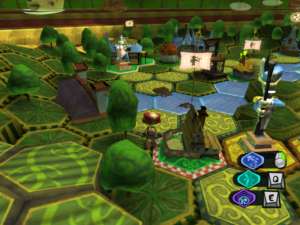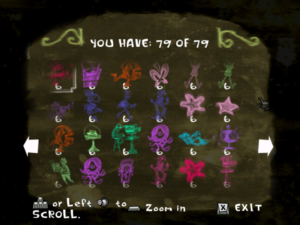The hype over the new Prince of Persia game inspired me to do something I’ve been meaning to do for a while: replay Prince of Persia: The Sands of Time, the 3D platforming game that reawakened the dormant franchise. Apart from just wanting to refamiliarize myself with its plot events to see if the sequels make any sense at all in terms of them, I had a specific goal in mind. I wanted to master the wall rebound.
The wall rebound consists of leaping feet-first toward a wall and then propelling yourself sword-first toward an enemy. It’s one of several special acrobatic combat maneuvers in the game that can knock an enemy down instantly, and like all such maneuvers, it consists of a series of button-presses that I couldn’t tell you, even after mastering it. It does no good for the conscious mind to memorize such things. It has to go into muscle memory to be effective. At any rate, although I managed to pull it off accidentally a few times in my initial playthrough years ago, I never really learned how to do it. Instead, I had early on come to rely on the vault move, where you leapfrog over a foe and stab him from behind, which worked really well until I started encountering enemies that could block it, at which point I basically reverted to mundane swordplay. Some time afterward, an acquaintance of mine noted that he was pretty much exclusively using the wall jump in combat toward the end of the game, so I figured I should give it a try and see if it made the endgame easier.
Part of my thought on this matter was that it might be easier to learn all the moves if I used a proper gamepad. I have the PC version, and the first time through, I used mouse and keyboard. Well, it turns out there’s a reason I used mouse and keyboard: the PC version doesn’t support anything else. My gamepad driver can be set up to emulate a keyboard, but I didn’t bother, as it makes the analog controls iffy. Even using the mouse has its problems in that regard: where a modern gamepad gives you four analog degrees of freedom (via two sticks), keyboard/mouse only gives you two. As you might expect, the game binds (camera-relative) movement to the keyboard and uses the mouse for rotating the camera. This is usually adequate, because it lets you move in any direction by positioning the camera to point in that direction and moving forward. But there are a few scenes where the camera jumps to a fixed position and becomes temporarily immobile, and one particular such bit, where you have to swing on a rope and leap off towards a spot that’s just slightly off from straight forward, is made much harder than it should have been. But then, I suppose the parts where you walk along narrow beams are made easier by having a button you can press to go straight forward.
At any rate, I did manage to figure out the wall rebound, but it turns out to really be no more powerful than the vault. Yes, there are enemies who are vulnerable to the rebound and not the vault, but there are also enemies that are vulnerable to the vault and not the rebound. One of the last fight sequences consists entirely of wave after wave of three different sorts of big muscular-looking foes, one that’s vulnerable to the vault, one that’s vulnerable to the rebound, and one that’s vulnerable to neither and which, I speculate, must have some other weakness that I never discovered. This leads me to speculate about the intent behind the combat system: that it was intended to create increasing difficulty by means of increasingly specific weaknesses. Assume that there is in fact a third knock-down move. The earliest enemies would be vulnerable to all three. Tier two enemies would be able to block one move, tier three enemies would block two. The problem with this is that the player would have to be using all the special moves regularly from early on in order to notice it, and once you know one ultra-powerful move, you don’t have a lot of motivation to try anything else. (Call it the Double Dragon syndrome.) Now, I’ve looked at guides at Gamefaqs, and there really doesn’t seem to be any support for this theory there. But that might just be a symptom of the problem. At any rate, however it happened, the end result is that the game got a reputation for weak combat that ultimately resulted in the act of overcompensation titled Prince of Persia: Warrior Within.
But you know something? I don’t really care that the combat is weak and unvaried. Combat is not what this game is about. It’s about climbing things and dodging traps. Combat serves the purpose of breaking up the climbing scenes and providing a little variety, but the bulk of my time spent on the game was spent climbing things and dodging traps.
Or, to some extent, figuring out how to climb things. One thing that struck me the second time around is that this is basically a pretty short game — I can imagine someone who knows what he’s doing playing it from start to finish in a single session. It lasts as long as it does partly because of the time you spent wandering around confused, trying to figure out where you have to go next. The game tries to help you out: the camera is always trying to lead you to the right place by panning or zooming to show you your next goal, but I find that’s often not enough. There’s one bit in the final climb where I could enter a crack in a chimney-like hollow and couldn’t figure out how to get down without dying. The solution? I was supposed to be going up, not down. Once I figured this out, I remembered being stuck in the same place in the same way in my first play-through.
Overall, I’d say The Sands of Time still holds up well. The graphics aren’t quite as detailed as you’d expect today, but graphics had already more or less plateaued in their ability to impress. There’s a nice sense of mystery in the disappearing bonus areas of questionable reality — something that the sequels sensibly didn’t even try to address. And the two main characters, the nameless Prince and his sometime companion Farah, are appealingly human: working together but constantly bickering, plainly attracted to each other but, due to circumstances, unable to trust each other. The scene where the Prince muses to himself about the possibility of marrying Farah had me wincing at his clueless arrogance, but in a good way. This is something the sequels pretty much destroyed in their attempt to macho things up. Even when Farah shows up again in The Two Thrones, she’s been transformed into just another oversexed badass.
The really interesting thing about Farah is that she could easily be the protagonist of her own game, running concurrently with the Prince’s. Farah can go places the Prince can’t and vice versa, due to Farah’s ability to squeeze through small cracks and the Prince’s trademark wall-running, so they spend long periods of time separated. Who knows what puzzles she faces while you’re off doing your part? At one point, she leaves the Prince behind, and in the areas you go through as you try to catch up, the level designers conscientiously included a plausible route of narrow cracks for her.
I notice that I haven’t even mentioned the time-rewinding factor. I guess that means it was just a gimmick.
 Comments(4)
Comments(4)